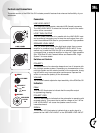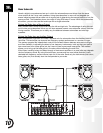
Mono Subwoofer
Here’s a slightly more advanced set-up in which the subwoofers are not driven from the same
mixer output as the 2-way main speakers. Using the subwoofers in mono will not degrade the
stereo image because the ear does not do a good job of determining the source location of low fre-
quency sound. The illustration shows two ways of using EON subs in mono. While two subwoofers
are shown, you can also use this technique with a single subwoofer.
Driving the Subs from a Mono Output
Many mixers have a mono output that sums the left and right mix. The advantage of using this out-
put to drive your subwoofers is that you will have separate control over subwoofer volume from the
mixing console. This allows you to easily vary the balance between subwoofers and mid/high
speakers.
Driving the Subs from an Auxiliar
y Output
Many professional engineers will create a separate mix for subwoofers from the Auxiliary buss of
the mixer. This technique can improve low-frequency system performance in a number of ways.
The system operator has independent control of the overall balance between subs and mid/highs
and more flexibility in adjusting the blend of low frequency instruments. Let’s say that you want to
hear more lows from a bass guitar but don’t want to hear more overall bass guitar. This method
allows you to bring up the bass guitar in the subs without effecting the main mix.
Wind noise, handling noise, and bleed through of instrument amplifiers in a vocal mike can degrade
the low-frequency sound. By using this technique, sources such as vocal mikes that don’t have
desirable low-frequency content can be kept out of the subs. Send only the instruments (kick drum,
bass guitar, etc.) that actually have low-frequencies to your subs.
10
LINE
MIC
O
U
T
P
U
T
1
I
N
P
U
T
LOOPMIX
R-PEAK
G-SIGNAL
1
2 & 3
2 & 3
2
3
LINE
MIC
O
U
T
P
U
T
1
I
N
P
U
T
LOOPMIX
R-PEAK
G-SIGNAL
1
2 & 3
2 & 3
2
3

















